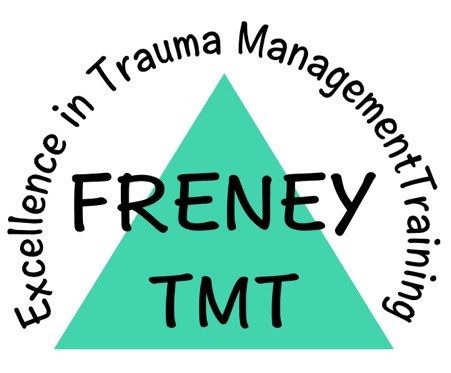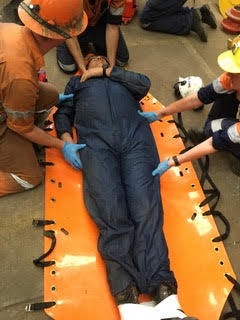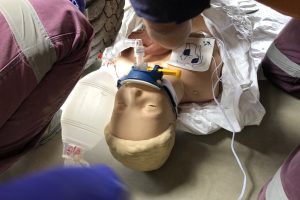Do we shock Asystole?!?
Now Sharon and I were working together again, what a good recipe for the shit to hit the
fan, as we always seemed to attract the good jobs.
Another afternoon in good old Auburn.
The phone rang, with a job for us over in Berala, apparently a man was having difficulty
breathing, and a call was made for us to go over and assist him.
Now breathing difficulties are not an uncommon call, so we made our way over to the
address in good time, expecting something like asthma or COPD (Chronic Obstructive
Pulmonary Disease).
On arrival, one of the family members met us at the front gate, and asked if we could hurry inside, (I’ll explain later, why you will never see a Paramedic rush into a house or to the scene of an accident).
So, we walked on in to the house, and were directed by the patients’ wife, into the
bedroom. Straight away, we knew there was going to be a problem, as the house was filled with boxes and other furniture items, making access difficult due to the lack of room. There were places in the hallway, where we had to step sideways to fit through the gaps. If we were going to have to carry this patient out, then we were going to be in trouble.
When we finally arrived at the bedroom, it only got worse. There were boxes stacked
against the wall, clothes piled up on the bed, and we could only gain access to one side of
the bed. As we inched into the room, that was when we noticed the so called breathing
difficulties, was now agonal breathing.
Agonal breathing is the breathing pattern that some people develop as they are going into
cardiac arrest, it sort of looks like a fish out of water, gulping air. Here was a perfect
example of it right in front of us. Again, ….. Shit!
The first thing we did, was cut his shirt open, and I handed Sharon the pads to put in place on his chest. He was that sweaty, that Sharon had to use the bed sheet to wipe his chest so we would have a hope of getting the pads to adhere, plus he was quite hairy, so I handed her the razor to shave some of the hair from his chest. I grabbed the oxyviva and broke out the resuscitation mask, leaving it on the bed, and turned on the defibrillator. I confirmed via radio that we had a code 2 (cardiac arrest), and I was informed that there were no I. C., or other crews available at that time. Double Shit!!
Sharon had the pads on the chest by now, and she started some compressions on his chest,while he was on the bed, (not the most ideal surface to do compressions on, but it was what we had).
At that, I started to look for ways to get this guy outside to the stretcher. I quickly asked the wife to get the neighbours, who she knew well, to come over, and shift the boxes out of the hallway. I directed them to just take them out into the front yard, so we could get the husband out onto the stretcher.
I radioed again for some backup, but there still was no one available to help us, so I did the best with what we had. I did however ask for the Fire Brigade to respond, as they could give us a hand by getting all of the rubbish out of the way, and helping us extricate the patient out, onto our stretcher.
The husband was not in a shockable rhythm, so we couldn’t shock him. All we could do was perform basic CPR on him.
When the Fire Brigade arrived, Sharon rallied them into giving us a hand to carry the
husband out on the carry sheet, so we rolled him over onto his side on the bed, and found
out that he had emptied his bowels onto the bed. Well, we got the carry sheet under him,
rolled him back, and continued some more CPR for another couple of minutes while the
neighbours and the fire brigade got the last of the stuff out of the hallway. When they said it was clear, Sharon organised them to come into the bedroom and move some of the junk near the doorway. We slid him to the end of the bed, and managed to carry him out. It wasn’t dignified or graceful, as we had to slide him along the floor at one stage, but we got him out to the stretcher. Once we had him loaded into the ambulance, I continued with single operator CPR, as Sharon drove the ambulance.
Again, enroute to the hospital, she radioed for assistance, but none was available, so she asked the coordinator to call the hospital and let them know we were coming in with an unassisted arrest, and we need them to be ready in the resuscitation room.
Well, we arrived at the hospital in good time, because I was getting bloody tired with the
single operator CPR. As we pulled up, the security met us in the driveway, and opened up
the back of the ambulance. Sharon pulled the stretcher out, as I tried to continue with
uninterrupted compressions. We wheeled him into the resuscitation room, and with some difficulty, transferred him onto the resuscitation bed.
Sharon continued to ventilate him, while I did compressions as the staff prepared the
resuscitation trolley. That was when the doctor walked into the room.
We gave a quick rundown on what we found, what we did, and where we were up to at the moment, to allow the doctor to direct the following procedures. We thought he understood what was going on, but he still seemed a little panicked.
To our surprise, he walked over to their defibrillator on the metal trolley, and wheeled it
over next to the bed. He proceeded to turn it on, and slid both of the paddles out of their
cradle, dialled up three hundred joules on the charge selector, and put them directly onto
the pads of our defibrillator.
The problem was a couple of things now.
One, I was still doing compressions on the guys chest when he put the charged paddles on
the chest.
Two, our pads were insulted, so no charge will go through them from the paddles.
Three, the patient was still in asystole (generally known to the public as flatline), and the
purpose of a defibrillator is to put the person into Asystole momentarily.
The general public have an incorrect idea of what a defibrillator actually does.
When a person is in a shockable cardiac rhythm, the defibrillator passes an electrical current
through the heart in an attempt to shut all of that irregular activity down momentarily,
allowing the heart to hopefully start itself back up again. So, in fact, the defibrillator is
designed to stop your heart completely for this to happen.
If he had actually pressed the shock button on the paddles at that stage, it could have
delivered some of that energy to myself and Sharon, who were in contact with the patient
at that time.
I asked in a very loud voice, to be heard by all, particularly the doctor, “do you guys now
shock asystole?” The nurse next to me replied, looking straight at the doctor, “No, doctor,
take the paddles off the patient”, to which he promptly took the paddles away.
To make matters worse, he placed the fully charged paddles directly down onto the metal
trolley, effectively creating a potential short circuit. Fortunately, one of the switched-on
staff members, (no pun intended), recognised this straight away and pushed the doctor to
the side, picked up the paddles by their handles, and slid them back into their cradle on the defibrillator. Disaster averted. At that, the doctor turned and walked out of the resuscitation room and left us, thankfully.
Well, we ran the arrest protocol with the hospital staff, and didn’t get any response from
the casualty, so we stopped the resuscitation procedure, acknowledging that he was now
deceased.
It may seem like a big effort to some, but we gave him the best chance at the time for
survival.
Fortunately, all of the following arrests we brought into the hospital, were when that
particular doctor was not on shift. Apparently, he only came into the hospital twice a month for shifts, the rest of the time he ran a medical centre in the local vicinity. I don’t think his heart, or his head for that fact, were in the right place for the emergency department.
We never rush into a house, or anywhere for that matter, and people often say we looked
so calm. Sometimes looks can be deceiving.
The reason we don’t rush, is because we have developed situational awareness.
What is situational awareness?
It is when you arrive at a new location, and you take the time to assess for access to where you need to go to, any possible dangers that may be present or imminent, and summing up what actions are going to be needed to commence and complete the task at hand. Danger can take the form of people and their actions or demeanour, animals, environmental concerns, or known physical hazards. If we rush in, we can put ourselves and others at risk.
We also importantly need to take stock of what we have to deal with, and this time, allows us to formulate a plan of action, and determine if we require further resources to carry out that plan of action. Part of that assessment also is to determine the best way of undertaking communication with the patient and other bystanders. There is quite a lot to do in those initial first seconds.




